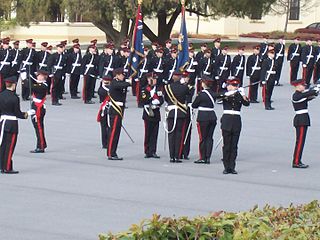
A military academy or service academy is an educational institution which prepares candidates for service in the officer corps. It normally provides education in a military environment, the exact definition depending on the country concerned.

The Uganda People's Defence Force (UPDF), previously known as the National Resistance Army, is the armed forces of Uganda. From 2007 to 2011, the International Institute for Strategic Studies estimated the UPDF had a total strength of 40,000–45,000 and consisted of land forces and an air wing. Recruitment to the forces is done annually.
Lieutenant general or lieutenant-general is a three-star military rank used in many countries. The rank traces its origins to the Middle Ages, where the title of lieutenant general was held by the second in command on the battlefield, who was normally subordinate to a captain general.
Defence Force(s) or Defense Force(s) is the title of the armed forces of certain countries.

The Alliance of Democratic Forces for the Liberation of Congo-Zaire was a coalition of Rwandan, Ugandan, Burundian, and Congolese dissidents, disgruntled minority groups, and nations that toppled Mobutu Sese Seko and brought Laurent-Désiré Kabila to power in the First Congo War. Although the group was successful in overthrowing Mobutu, the alliance fell apart after Kabila did not agree to be dictated by his foreign backers, Rwanda and Uganda, which marked the beginning of the Second Congo War in 1998.
Ministry of Defence or Ministry of Defense may refer to:
The Front for National Salvation (FRONASA) was a Ugandan rebel group led by Yoweri Museveni. The group factually emerged in 1971, although it was formally founded in 1973. FRONASA, along with other militant groups such as Kikosi Maalum, formed the Uganda National Liberation Front (UNLF) and its military wing the Uganda National Liberation Army (UNLA) in 1979 to fight alongside Tanzanian forces against Idi Amin.

The Tanzania People’s Defence Force (TPDF) is the armed forces of Tanzania. They were set up in September 1964, following a mutiny by the former colonial military force: the Tanganyika Rifles. From its inception, it was ingrained in the troops of the new TPDF that they were a people’s force under civilian control. Unlike some of its neighbors, Tanzania has never suffered a coup d'état or civil war.
People's Army/Armed Forces is/was the title of the armed forces of several countries:
Kikosi Maalum, also known as the Special Battalion or the grand coalition, was a militia of Ugandan exiles formed in Tanzania to fight against the regime of Idi Amin. The unit was founded by and loyal to former Ugandan President Milton Obote, and served as his de facto private army. It was commanded by former army officers David Oyite-Ojok, and Tito Okello. Kikosi Maalum took part in the Uganda–Tanzania War, fighting alongside the Tanzanian military against Amin's forces. In course of this conflict, the militia was nominally unified with other Ugandan rebel groups, forming the Uganda National Liberation Army (UNLA) in 1979. After the fall of Amin's regime and Obote's return to power, Kikosi Maalum became the core of Uganda's new national army.

The Karenni Army is the armed wing of the Karenni National Progressive Party (KNPP), and operates in eastern Kayah State, Myanmar (Burma).

The Tanzania Air Force Command is the national air force of Tanzania. The current Commander of the Tanzania Air Force Command is Major General William Ingram, who replaced Major General Joseph Kapwani upon the latter's retirement in January 2016.
Rank comparison chart of armies/ land forces of Commonwealth of Nations states.
Rank comparison chart of officer ranks for armies/land forces of African states.
Rank comparison chart of enlisted rank for armies/ land forces of African states.

Ugandan People's Defence Force Air Force, more commonly known as Ugandan Air Force, is the branch of the Uganda People's Defence Force that deals with the air warfare. It headquarters is located at Entebbe, Uganda. The current air force commander is Charles Lutaaya, while Emmanuel Kwihangana serves as chief of air staff.

The 1972 invasion of Uganda was an armed attempt by Ugandan insurgents, supported by Tanzania, to overthrow the regime of Idi Amin. Under the orders of former Ugandan President Milton Obote, insurgents launched an invasion of southern Uganda with limited Tanzanian support in September 1972. The rebel force mostly consisted of the "People's Army" whose forces were mainly loyal to Obote, but also included guerillas led by Yoweri Museveni. The operation was hampered by problems from the start, as a planned rebel commando raid had to be aborted, Amin was warned of the impending invasion, and the rebels lacked numbers, training, and equipment. Regardless, the militants occupied a few towns in southern Uganda at the invasion's start. However, no major popular uprising erupted as Obote had hoped.

The People's Defence Force is the armed wing of the National Unity Government (NUG), a body claiming to be the legitimate government of Myanmar. The armed wing was formed on 5 May 2021 in response to the coup d'état that occurred on 1 February 2021 and ongoing violence of the junta. The military junta designated it as a terrorist organisation on 8 May.
This page is based on this
Wikipedia article Text is available under the
CC BY-SA 4.0 license; additional terms may apply.
Images, videos and audio are available under their respective licenses.








